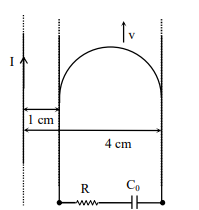JEE Advanced Physics Question Paper with Solution JEE Advanced 2021 Paper 1
A
3.07 cm
B
3.11 cm
C
3.15 cm
D
3.17 cm
Solution
So, we have given,
$10 VSD =9 MSD \Rightarrow 1 VSD =\frac{9}{10} MSD$
Least count $=1 MSD -1 VSD =\left(1-\frac{9}{10}\right) MSD$
$\Rightarrow 0.1 MSD =0.1 \times 0.1=0.01 cm$
As ' $O$ ' of vernier scale lies before ' $O$ ' of the main scale,
Zero error $=-(10-6) \times($ Least Count $)=-4 \times 0.01=-0.04 cm$
Reading $=3.1+1 \times($ Least count $)=3.1+1 \times 0.01=3.11 cm$
Therefore, true diameter $=$ Reading $-$ Zero error
$
=3.11-(-0.04)=3.15 cm
$
A
steps 1 and 2
B
steps 1 and 3
C
steps 1 and 4
D
steps 2 and 4
Solution
$\Delta Q_{1}=n C_{p} \Delta T>0$
$\Delta Q_{2}=n C_{V} \Delta T<0$
$\Delta Q_{3}=n C_{p} \Delta T<0$
$\Delta Q_{4}=n C_{V} \Delta T>0$
A
0.4
B
0.8
C
1.3
D
1.6
Solution
$\frac{1}{ f _{1}}=(1.5-1)\left(\frac{1}{20}+\frac{1}{20}\right)=\frac{1}{20}$
$\frac{1}{ f _{2}}=(1.5-1)\left(-\frac{1}{20}-\frac{1}{20}\right)=-\frac{1}{20}$
So, $\frac{1}{ v }-\frac{1}{-10}=\frac{1}{20}$
So, $v =-20\, cm$
and $\frac{1}{v^{\prime}}-\frac{1}{-30}=\frac{1}{-20}$
So, $v^{\prime}=-12 \,cm$
So total magnification $=\left(\frac{-20}{-10}\right)\left(\frac{-12}{-30}\right)=0.8$
A
50
B
75
C
350
D
525
Solution
Total no. of decays in $60$ minutes
$=1000-1000\left(\frac{1}{2}\right)^{3}=875$
So, no. of $\alpha$-decay $=875 \times 0.6=525$
Answer: 0.50
Solution
After splitting $1^{\text {st }}$ mass takes $0.5 \,sec$ to reach ground.
Initial velocity is same for both mass at the highest point in vertical direction. Displacement and acceleration in vertical direction is also same
So, $2^{\text {nd }}$ mass will also take $0.5\, sec$ to reach ground.
Answer: 7.50
Solution

Velocity of projectile at highest point $5\, m / s \hat{ i }$
Since, there is no external force in horizontal direction so by conservation of momentum
$m (5)=\frac{ m }{2}(0)+\frac{ m }{2}( v )$
$\vec{ v }=10 \,m / s \hat{ i }$
Distance covered by second mass before landing = $\frac{\text { Range }}{2}+10(t)=7.5\, m$
Answer: 1.33
Solution

After long time we can replace the capacitor by open circuit.

$i$ current in circuit $=1 / 3$ ampere
$v _{ AB }=2-2\left(\frac{1}{3}\right)=\frac{4}{3}$ volt
So, $q _{1}= CV =\frac{4}{3} \mu C$
Answer: 0.67
Solution

After long time $i$ circuit $=\frac{2}{3}$ ampere

$v _{ AB }=2-2\left(\frac{2}{3}\right)=\frac{2}{3}$ volt
So, $q _{2}= CV =(1)\left(\frac{2}{3}\right)=\frac{2}{3} \mu C$
Answer: 1.73
Solution

Lets take two points $( a , 0)$ and $( C , 0)$ on equipotential circle.
Net potential at $( C , 0)=0$
$\frac{K(-q)}{C}+\frac{K q}{\frac{\sqrt{3}}{(C-2)}}=0$
$\frac{1}{C}=\frac{1}{\sqrt{3}(C-2)} $
$\Rightarrow \sqrt{3} C-2 \sqrt{3}=C$
$\Rightarrow (\sqrt{3}-1) C =2 \sqrt{3} $
$\Rightarrow C =\frac{2 \sqrt{3}}{\sqrt{3}-1}$
Potential net at $(a, 0)=0$
$\frac{K(-q)}{a}+\frac{K \frac{q}{\sqrt{3}}}{(2-a)}=0 $
$\Rightarrow \frac{1}{a}=\frac{1}{\sqrt{3}(2-a)} $
$\Rightarrow 2 \sqrt{3}-\sqrt{3} a=a $
$\Rightarrow a=\frac{2 \sqrt{3}}{1+\sqrt{3}}$
So, Radius $=\frac{C-a}{2}=\frac{\frac{2 \sqrt{3}}{\sqrt{3}-1}-\frac{2 \sqrt{3}}{\sqrt{3}+1}}{2}$
$=\sqrt{3}\left(\frac{1}{\sqrt{3}-1}-\frac{1}{\sqrt{3}+1}\right)=\sqrt{3}\left(\frac{\sqrt{3}+1-\sqrt{3}+1}{3-1}\right) $
Radius $=\sqrt{3}$
Answer: 3.00
Solution
$b = a +$ radius
$=\frac{2 \sqrt{3}}{\sqrt{3}+1}+\sqrt{3}=\frac{2 \sqrt{3}+3+\sqrt{3}}{1+\sqrt{3}}$
$=\frac{3 \sqrt{3}+3}{1+\sqrt{3}}=3$
Center $=(3,0)$
A
For the same F, the value of $a$ does not depend on whether the cylinder is solid or hollow
B
For a solid cylinder, the maximum possible value of $a$ is $2 \mu g$
C
The magnitude of the frictional force on the object due to the ground is always $\mu mg$
D
For a thin-walled hollow cylinder, $a=\frac{F}{2 m}$
Solution

$F - f = ma $
$ fR = I \alpha $ (about center of mass)
$ a = R \alpha$ (pure rolling)
For hollow cylinder $a=\frac{F}{2 m}, f=\frac{F}{2}$
For solid cylinder, $a=\frac{2 F}{3 m}, f=\frac{F}{3}$
Also for solid cylinder $\frac{F}{2} \leq \mu\, mg$
Therefore a $\leq 2\, \mu g$
A
The light ray enters air if $n_{2}=n_{1}$
B
The light ray is finally reflected back into the medium of refractive index $n _{1}$ if $n _{2}< n _{1}$
C
The light ray is finally reflected back into the medium of refractive index $n_{1}$ if $n_{2}>n_{1}$
D
The light ray is reflected back into the medium of refractive index $n_{1}$ if $n_{2}=1$
Solution
The ray diagram for the following conditions are


The light finally must reflected back in medium of refractive index $n_1$ for all values of $n_2$.
A
The particle arrives at the point $(x=\ell, y=-h)$ at time $t=2 s$.
B
$\vec{\tau}=2 \hat{k}$ when the particle passes through the point $(x=\ell, y=-h)$
C
$\vec{ L }=4 \hat{ k }$ when the particle passes through the point $( x =\ell, y =- h )$
D
$\vec{\tau}=\hat{k}$ when the particle passes through the point $(x=0, y=-h)$
Solution
Time taken to reach from $(-\ell,- h )$ to $(\ell,- h )$ is given by
$2 \ell=\frac{1}{2} at ^{2} $
$20=\frac{1}{2}(10) t ^{2} $
$ t =2\, sec $
$\vec{ L }= mvh \hat{ k }= math \hat{ k }$
$\vec{ L }=(0.2)(10) 2(1) \hat{ k }=4 \hat{ k }$ [ when particle passes through $ (\ell,- h )] $
$\vec{\tau}=\frac{ d \vec{ L }}{ dt }= mah \hat{ k }=(0.2)(10)(1) \hat{ k }=2 \hat{ k } $ (always)
A
The ratio of the longest wavelength to the shortest wavelength in Balmer series is $9 / 5$
B
There is an overlap between the wavelength ranges of Balmer and Paschen series
C
The wavelength of Lyman series are given by $\left(1+\frac{1}{ m ^{2}}\right) \lambda_{0}$, where $\lambda_{0}$ is the shortest wavelength of Lyman series and $m$ is an integer
D
The wavelength ranges of Lyman and Balmer series do not overlap
Solution
For hydrogen atom, $z =1$
$\frac{1}{\lambda}= R \left(\frac{1}{ n _{1}^{2}}-\frac{1}{ n _{2}^{2}}\right)$,
where $R =1.0973 \times 10^{7} m ^{-1}$
$=1.1 \times 10^{7} m ^{-1}=$ Rydberg constant.
For the Lyman series, $n _{1}=1$ and $n _{2}=2,3,4, \ldots \ldots \infty$
$\frac{1}{\lambda}= R \left(1-\frac{1}{ n _{2}^{2}}\right) $
$\lambda=\lambda_{\max }, $ when $ n _{2}=2$
$\frac{1}{\lambda_{\max }}=\frac{3 R }{4} $
$\Rightarrow \lambda_{\max }=\frac{4}{3 R }=121.5\, nm $
$\lambda=\lambda_{\min },$ when $n _{2}=\infty $
$\frac{1}{\lambda_{\min }}= R $
$\Rightarrow \lambda_{\min }=\frac{1}{ R }=91.1\, nm$
Also, $ \lambda=\left(\frac{ n _{2}^{2}}{ n _{2}^{2}-1}\right) \frac{1}{ R }=\left[1+\frac{1}{\left( n _{2}^{2}-1\right)}\right] \lambda_{0}$
$=\left(1+\frac{1}{ m ^{2}}\right) \lambda_{0} $
$\lambda=\left(1+\frac{1}{ m ^{2}}\right) \lambda_{0}$
where,
$ m ^{2}=\left( n _{2}^{2}-1\right)=$ an integer
$ m =\sqrt{ n _{2}^{2}-1}=$ not an integer
For the Balmer series, $n _{1}=2$ and $n _{2}=3,4,5,6,........, \infty$
$\frac{1}{\lambda}=R\left(\frac{1}{4}-\frac{1}{n_{2}^{2}}\right)$
$\lambda=\lambda_{\max }$, when $n _{2}=3$
$\frac{1}{\lambda_{\max }}=\frac{5 R }{36}$
$\lambda_{\max }=\frac{36}{5 R }=656.2\, nm$
$\lambda=\lambda_{\min }$, when $n _{2}=\infty$
$\Rightarrow \lambda_{\min }=\frac{4}{ R }=364.5\, nm$
Hence, for the Balmer series,
$\frac{\lambda_{\max }}{\lambda_{\min }}=\frac{36 / 5 R }{4 / R }=\frac{9}{5}$
For the Paschen series, $n _{1}=3$ and $n _{2}=4,5,6, \ldots \ldots ., \infty$
$\frac{1}{\lambda}= R \left(\frac{1}{9}-\frac{1}{ n _{2}^{2}}\right)$
$\lambda=\lambda_{\max }$, when $n _{2}=4$
$\frac{1}{\lambda_{\max }}= R \left(\frac{1}{9}-\frac{1}{16}\right)=\frac{7 R }{144}$
$\Rightarrow \lambda_{\max }=\frac{144}{7 R }=1874.7 \,nm$
$\frac{1}{\lambda_{\max }}= R \left(\frac{1}{9}-\frac{1}{16}\right)=\frac{7 R }{144}$
$\Rightarrow \lambda_{\max }=\frac{144}{7 R }=1874.7\, nm$
$\lambda=\lambda_{\min }$, when $n _{2}=\infty$
$\frac{1}{\lambda_{\min }}=\frac{ R }{9}$
$ \Rightarrow \lambda_{\min }=\frac{9}{ R }=820.2\, nm$
A
Maximum current through $R$ is $1.2 \times 10^{-6}$ ampere
B
Maximum current through $R$ is $3.8 \times 10^{-6}$ ampere
C
Maximum charge on capacitor $C_{0}$ is $8.4 \times 10^{-12}$ coulomb
D
Maximum charge on capacitor $C_{0}$ is $2.4 \times 10^{-12}$ coulomb
Solution
Emf induced across the semi-circular conducting rod.
$\varepsilon=\int\limits_{1}^{4} \frac{\mu_{0} I v d x}{2 \pi x}$
$=\frac{\mu_{0} I v}{2 \pi} \ln (4)=\frac{\mu_{0} I v}{\pi} \ln (2)$
Since the semi-circular conducting rod is moving with a constant speed
$v =3\, m / s$,
then $\varepsilon=\frac{\mu_{0} I v}{\pi} \ln (2)=$ constant
Maximum current through the resistor $R$ is
$i _{\max }=\frac{\varepsilon}{ R }=\frac{\mu_{0} Iv }{\pi R } \ln (2)$
$=\frac{4 \times 10^{-7} \times 2 \times 3 \times 0.7}{1.4}$
$=1.2 \times 10^{-6} $ ampere.
Maximum charge on the capacitor $C _{0}$ is
$q _{\max }= C _{0} \varepsilon= C _{0}\left(\frac{\mu_{0} Iv }{\pi} \ln (2)\right)$
$=5 \times 10^{-6} \times 4 \times 10^{-7} \times 2 \times 3 \times 0.7$
$=8.4 \times 10^{-12}$ coulomb.
A
$\beta=0$ when $a=g / \sqrt{2}$
B
$\beta > 0$ when $a=g / \sqrt{2}$
C
$\beta=\frac{\sqrt{2}-1}{\sqrt{2}}$ when $a = g / 2$
D
$\beta=\frac{1}{\sqrt{2}}$ when $a = g / 2$
Solution
$\left(P_{1}-P_{2}\right) d s=\rho d s d \sqrt{2}(g \sin 45-a)$
$\left(P_{1}-P_{2}\right)=\rho d(g-a \sqrt{2})$
$\beta=\frac{\left(P_{1}-P_{2}\right)}{\rho g d}=\left(1-\frac{a \sqrt{2}}{g}\right)$
When $a=g / \sqrt{2}, \beta=0$
When $a=g / 2, \beta=\left(\frac{\sqrt{2}-1}{\sqrt{2}}\right)$
Answer: 4
Solution
$ r _{a} =\frac{\sqrt{2 m _{a} q _{a} V }}{ q _{a} B }$
$ r _{ S } =\frac{\sqrt{2 m _{ S } q _{ s } V }}{ q _{ s } B } $
$\frac{ r _{ S }}{ r _{a}} =\sqrt{\frac{ m _{ s }}{ q _{ S }} \frac{ q _{a}}{ m _{ a }}}=\sqrt{\left(\frac{32}{1}\right)\left(\frac{2}{4}\right)} $
$\frac{ r _{ s }}{ r _{a}} =4$
Answer: 49
Solution
Angular momentum of disc about $O$ is
$L _{ DO }= M \left(\frac{3 a }{4}\right)\left(\frac{3 a }{4}\right) \Omega+\frac{ M }{2}\left(\frac{ a }{4}\right)^{2}(4\, \Omega)$
Angular momentum of rod about $O$ is
$L _{ RO }=\frac{ Ma ^{2}}{3} \Omega$
So, $L _{0}= L _{ DO }+ L _{ Ro }=\frac{49}{48}\left( Ma ^{2} \Omega\right)$
So, $n =49$
Answer: 9
Solution
$- C \frac{ dT }{ dt }=\left( T ^{4}- T _{ s }^{4}\right)$
$\int\limits_{200}^{100} \frac{ dT }{ T ^{4}- T _{ s }^{4}}=\int\limits_{0}^{ t }-\frac{1}{ c } dt$
$-\frac{1}{3}\left[\frac{1}{ T ^{3}}\right]_{200}^{100}=-\frac{1}{ c }\left( t _{1}\right)$
$\Rightarrow \left[\frac{1}{(100)^{3}}-\frac{1}{(200)^{3}}\right]=\frac{3}{ c } t _{1}$
Similarly, $\left[\frac{1}{(50)^{3}}-\frac{1}{(200)^{3}}\right]=\frac{3}{ c } t _{2}$
$\frac{ t _{2}}{ t _{1}}=\frac{\left[\frac{1}{(50)^{3}}-\frac{1}{(200)^{3}}\right]}{\left[\frac{1}{(100)^{3}}-\frac{1}{(200)^{3}}\right]}=9$
JEE Advanced Chemistry Question Paper with Solution JEE Advanced 2021 Paper 1
A

B

C

D

Solution

$Na$ in liquid $NH_3$ reduces non terminal alkyne into trans alkene.
A
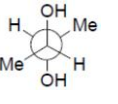
B
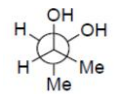
C
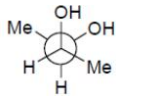
D
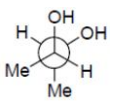
Solution
In option (B), given configuration represents meso - butane -$ 2, 3$-diol and due to intramolecular hydrogen
bonding, the gauche form is more stable.
Option (C) and (D) does not represent meso - isomer.
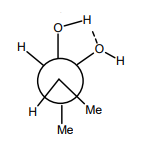
A
0.74
B
0.63
C
0.52
D
0.48
Solution
Packing fraction $(f)=\frac{3 \times \frac{4}{3} \pi r_{+}^{3}+1 \times \frac{4}{3} \pi r_{-}^{3}}{a^{3}}$
$=\frac{1 \times \frac{4}{3} \pi\left[3\left(\frac{r_{+}}{r_{-}}\right)^{3}+1\right]}{\left(\frac{a}{r}\right)^{3}}$
Now $2 r _{-}= a$
$\therefore \frac{a}{r_{-}}=2$
Also, $\frac{r_{\text {土 }}}{r_{-}}=0.414$
So, $f=\frac{1 \times \frac{4}{3} \times 3.14\left[3 \times(0.414)^{3}+1\right]}{(2)^{3}}$
$=0.634 \approx 0.63$
A
3.87 and 2.84
B
4.90 and 1.73
C
3.87 and 1.73
D
4.90 and 2.84
Solution
$\left[ Cr \left( NH _{3}\right)_{6}\right]^{3+}$ has $d ^{3}$ configuration, so as per $CFT$,
$N =3$ and $\mu=\sqrt{3(3+2)}=3.87 \,BM$
$\left[ CuF _{6}\right]^{3-}$, has $d ^{8}$ configuration and weak field ligand.
So $N =2$ and $\mu=\sqrt{2(2+2)}=2.84\, BM$
Answer: 1.62
Solution


Molar mass of $P = 40$
$\underset{(0.1 \text{mole})}{ P} \xrightarrow{75\%} \underset{(0.1 \times \frac{3}{4})}{Q}$
$\underset{(0.1 \times \frac{3}{4})}{3Q} \xrightarrow{40\%} \underset{(\frac{1}{3} \times 0.1 \times \frac{3}{4} \times 0.4)}{R}$
So, moles of $R = 0.01$ mole
Molar mass of $(R) = 162$
So, $x = 0.01 \times 162 = 1.62\,g$
Answer:
Solution
Molar mass of ' $U$ ' $=122 \,g$ or $100 \,g$
$\underset{(0.1 \text { mole })}{ P } \xrightarrow{100 \%} \underset{(0.1 \text { mole })}{ S }$
$\underset{(0.1\text{mole})}{2S} \xrightarrow[(80\%)]{\text{Aldol condensation}} \underset{(\frac{0.1}{2} \times 0.8)}{T} \xrightarrow{80\%} \underset{(\frac{0.1}{2} \times 0.8\times .8)}{U}$
So, mass of '$U$' $=\frac{0.1}{2} \times 0.8 \times 0.8 \times 100=3.20\, gm$
Or
Mass of ' $U$ ' $=\frac{0.1}{2} \times 0.8 \times 0.8 \times 122=3.90\, gm$
Answer: 166.28
Solution
$ X ( s ) \rightleftharpoons Y ( s )+ Z ( g ) $
$ K _{ p }=\frac{ p _{ z }}{ p ^{0}}, $ also$ \Delta G ^{0}=- RT \ln k _{ p } $
$=- RT \ln \left(\frac{ p _{ z }}{ p ^{0}}\right)$
Now, $\Delta G ^{0}=\Delta H ^{0}- T \Delta S ^{0}$
$- RT$ kn $\left(\frac{ p _{z}}{ p ^{0}}\right)=\Delta H ^{0}- T \Delta S ^{0}$
$\ln \left(\frac{p_{z}}{p^{0}}\right)=-\left(\frac{\Delta H^{0}}{R}\right) \frac{1}{T}+\frac{\Delta S^{0}}{R}$ ....(1)

$(1) \Rightarrow \ln \left(\frac{p_{z}}{p^{0}}\right)=-\left(\frac{\Delta H^{0}}{10^{4} R}\right) \times \frac{10^{4}}{T}+\frac{\Delta S^{0}}{T} \ldots(2)$
Slope of the line $=-\frac{\Delta H ^{0}}{10^{4} R }$
$=\frac{[-7-(-3)]}{12-10}=-2$
$\therefore \Delta H ^{0}=2 R \times 10^{4}$
$=2 \times 8.314 \times 10^{-3} \times 10^{4}$
$=1.66 .28\, kJ \,mol ^{-1} K ^{-1}$
Answer: 141.34
Solution
$ X ( s ) \rightleftharpoons Y ( s )+ Z ( g ) $
$ K _{ p }=\frac{ p _{ z }}{ p ^{0}}, $ also$ \Delta G ^{0}=- RT \ln k _{ p } $
$=- RT \ln \left(\frac{ p _{ z }}{ p ^{0}}\right)$
Now, $\Delta G ^{0}=\Delta H ^{0}- T \Delta S ^{0}$
$- RT$ kn $\left(\frac{ p _{z}}{ p ^{0}}\right)=\Delta H ^{0}- T \Delta S ^{0}$
$\ln \left(\frac{p_{z}}{p^{0}}\right)=-\left(\frac{\Delta H^{0}}{R}\right) \frac{1}{T}+\frac{\Delta S^{0}}{R}$ ....(1)

$(1) \Rightarrow \ln \left(\frac{p_{z}}{p^{0}}\right)=-\left(\frac{\Delta H^{0}}{10^{4} R}\right) \times \frac{10^{4}}{T}+\frac{\Delta S^{0}}{T} \ldots(2)$
Putting the value of $\Delta H ^{0}$ in equation (2), we get
$-3=-\left(\frac{2 R \times 10^{4}}{10^{4} R }\right) \times \frac{10^{4}}{7}+\frac{\Delta S ^{0}}{ R } $
$-3=-2 R \times \frac{10^{4}}{ T }+\frac{\Delta S ^{0}}{ R }$
$-3=-2 \times \frac{10^{4}}{1000}+\frac{\Delta S ^{0}}{ R } $
$-3=-20+\frac{\Delta S ^{0}}{ R }$
$\therefore \frac{\Delta S ^{0}}{ R }=17$
$\therefore \Delta S ^{0}=17 \times 8.314$
$=141.34 \,J\,K ^{-1} mol ^{-1}$
Answer: 100.10
Solution
$0.1$ molal $AgNO _{3}$ (aq) solution
$ AgNO _{3} \longrightarrow Ag ^{+}( aq )+ NO _{3}{ }^{-}( aq )$
$ i =1+(2-1) \times 1=2(\alpha=1,$ given )
$\Delta T _{ b }= i \times k _{ b } \times m $
$\Delta T _{ b }=2 \times 0.5 \times 0.1=0.1$
So, boiling point of solution ' $A$ ' is $=100.10^{\circ} C = x$
Answer: 2.5
Solution
Let solution ' $B$ ' is prepared by mixing $1 \,L$ ( $=1000\, g$ ) of solution '$A$' with $1 \,L$ (= $1000\, g$ ) of solution of $BaCl _{2}$.

So, molality of new solution $=\left(\frac{ i _{1} \times m _{1}+ i _{2} \times m _{2}}{2}\right)$
$=\left(\frac{3 \times 0.05+3 \times 0.05}{2}\right) $
$=0.15 $
Now, Elevation of boiling point of solution ' $B$ ' be $\left(\Delta T_{b}{ }^{1}\right)$
$\Delta T _{ b }^{1}=0.15 \times k _{ b } $
$=0.15 \times \frac{1}{2} $
$=0.075$
Now, $T _{ b }{ }^{1}=100.075{ }^{\circ} C$
So, difference of boiling point of ' $A$ ' and ' $B$ '
$=100.10-100.075=0.025= y \times 10^{-2}$ (given)
So, $y =2.5$
A

B

C

D
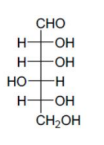
Solution

Since, we have to get the product $(x)$ of $(\alpha)_{0}=-52.7^{0}$, i.e. the enantiomer of above product. Which is only possible from (C) $\&$ (D).


A

B
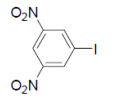
C

D

Solution
In option (B) and (C), $NO _{2}$ group (an EWG) is not present ortho or para position wrt the leaving group, so $ArSN ^{2}$ reaction will not be possible.


A
The process of precipitating colloidal sol by an electrolyte is called peptization.
B
Colloidal solution freezes at higher temperature than the true solution at the same concentration.
C
Surfactants form micelle above critical micelle concentration (CMC). CMC depends on temperature.
D
Micelles are macromolecular colloids.
Solution
(A) Process of precipitating colloidal solution by using an electrolyte is called "COAGULATION" and not peptisation.
(B) Since, molar mass of sol is much higher than true solutions, so magnitude of any colligative properties is smaller than true solutions.
$\left(\Delta T _{ f }\right)_{\text {sol }}<\left(\Delta T _{ f }\right)_{\text {true solution }}$
So, freezing point of sols $>$ freezing point of true solution.
So, option (B) is correct.
(C) Micells are formed greater than or equal to CMC and above KRAFT temperature.
So option (C) is also correct.
(D) Micelles are ASSOCIATED colloids and not Macromolecular colloids.
A
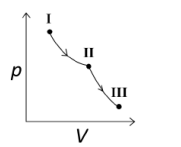
B

C
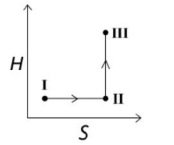
D
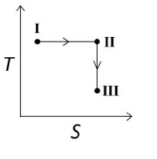
Solution
$(I) \xrightarrow[\text{expansion}]{\text{Reversible isotherm}} (II) \xrightarrow[\text{expansion}]{\text{Reversible adiabatic}} (III)$
So, the correct option is/are:



Reversible isothermal process is isoenthalpic while reversible adiabatic process is isoentropic.
A
A mixture of $PbS$ and $PbO$ undergoes self-reduction to produce $Pb$ and $SO_2$.
B
In the extraction process of copper from copper pyrites, silica is added to produce copper silicate.
C
Partial oxidation of sulphide ore of copper by roasting, followed by self-reduction produces blister copper.
D
In cyanide process, zine powder is utilized to precipitate gold from $Na \left[ Au ( CN )_{2}\right]$.
Solution
(A) $PbS +2 PbO \xrightarrow{\text { self reduction }}3 Pb + SO _{2} \uparrow$
So option (A) is correct.
(B) In the extraction $Cu$ from copper pyrite $CuFeS _{2}$
$SiO _{2}$ is added to remove $FeO$ as slag $FeSiO _{3}$.
So option (B) is wrong.
(C) $\underset{\text { concentrated ore }}{ CuF e S _{2}} \xrightarrow{\text { roasting }} \underbrace{ Cu _{2} S + FeS }_{\text {(matte) }}+ SO _{2}$
$FeS + O _{2} \longrightarrow FeO + SO _{2}$
$Cu _{2} S + O _{2} \longrightarrow Cu _{2} O + SO _{2}$
$Cu _{2} S +2 Cu _{2} O \longrightarrow \underset{\text { (Bister copper) }}{6 Cu }+ SO _{2}$
So, option (C) is correct.
(D) $Zn +2 Na \left[ Au ( CN )_{2}\right] \rightarrow Na _{2}\left[ Zn ( CN )_{4}\right]+2 Au \downarrow$
So, option (D) is correct.
A
$Pb \left( NO _{3}\right)_{2}$ and $Zn \left( NO _{3}\right)_{2}$
B
$Pb \left( NO _{3}\right)_{2}$ and $Bi \left( NO _{3}\right)_{3}$
C
$AgNO _{3}$ and $Bi \left( NO _{3}\right)_{3}$
D
$Pb \left( NO _{3}\right)_{2}$ and $Hg \left( NO _{3}\right)_{2}$
Solution
$Pb ( OH )_{2}, Zn ( OH )_{2}$ and $Bi ( OH )_{3}$ are white precipitates but $Hg ( OH )_{2}$ (unstable) is not. $PbCl _{2}$ is white $ppt$.
So, option (A), (B) and (C) are correct.
Answer: 6
Solution
Possible structural isomers are:

JEE Advanced Mathematics Question Paper with Solution JEE Advanced 2021 Paper 1
A
$x^{2}+y^{2}-3 x+y=0$
B
$x^{2}+y^{2}+x+3 y=0$
C
$x^{2}+y^{2}+2 y-1=0$
D
$x^{2}+y^{2}+x+y=0$
Solution

Image of orthocentre about any side of the triangle lies on its circumcircle.
We can observe that
$x^{2}+y^{2}+x+3 y=0$ is satisfied by $(-1,0)$ and $(1,-1)$ both
So, option (B) is the correct choice
A
$\frac{11}{32}$
B
$\frac{35}{96}$
C
$\frac{37}{96}$
D
$\frac{13}{32}$
Solution

Area of shaded region
$=\frac{1}{2}\left(\frac{2}{3}+\frac{3}{4}\right) \frac{1}{4}+\frac{1}{2} \times \frac{2}{3} \times \frac{1}{2} $
$=\frac{11}{32}$
A
$\frac{1}{5}$
B
$\frac{3}{5}$
C
$\frac{1}{2}$
D
$\frac{2}{5}$
Solution
$S_1$
$F_2 = F_1 \cup S_1$
$S_2$
$G_1 \cup S_2 = G_2$
$S_3$
(i)
$\{1, 2\}$
$\{1, 2, 3, 4\}$
$\{1, x\}$
$\{1,2,3,4,5\}$
$\{1,2\}$
(ii)
$\{2, 3\}$
$\{1,2,3,4\}$
$\{1,x\}$
$\{1,2,3,4,5\}$
$\{2,3\}$
$\{x, y\}$ (where $x$ and $y$
or $\{2,3,4,5\}$
(iii)
$\{1,3\}$
$\{1,3,4\}$
$\{1, x\}$ are other than 1$)$
$\{1,2,3,4,5\}$
$\{1,3\}$
(i) $ P_{1}=\frac{{ }^{2} c_{2}}{{ }^{3} c_{2}} \cdot \frac{{ }^{3} c_{1}}{{ }^{4} c_{2}} \cdot \frac{{ }^{2} c_{1}}{{ }^{5} c_{2}}=\frac{1}{60}$
(ii) $ P_{2}=\frac{1}{3}\left(\frac{{ }^{3} c _{1}}{{ }^{4} c _{2}} \times \frac{{ }^{2} c _{2}}{{ }^{5} c _{2}}+\frac{{ }^{3} c _{2}}{{ }^{4} c _{2}} \times \frac{{ }^{2} c _{2}}{{ }^{4} c _{2}}\right)=\frac{2}{45}$
(iii) $ P_{3}=\frac{1}{{ }^{3} c_{1}} \times \frac{{ }^{2} c_{1}}{{ }^{3} c_{2}} \times \frac{{ }^{2} c_{2}}{{ }^{5} c_{2}}=\frac{1}{45}$
Conditional probability $=\frac{P_{1}}{P_{1}+P_{2}+P_{3}}=\frac{1}{5}$
| $S_1$ | $F_2 = F_1 \cup S_1$ | $S_2$ | $G_1 \cup S_2 = G_2$ | $S_3$ | |
|---|---|---|---|---|---|
| (i) | $\{1, 2\}$ | $\{1, 2, 3, 4\}$ | $\{1, x\}$ | $\{1,2,3,4,5\}$ | $\{1,2\}$ |
| (ii) | $\{2, 3\}$ | $\{1,2,3,4\}$ | $\{1,x\}$ | $\{1,2,3,4,5\}$ | $\{2,3\}$ |
| $\{x, y\}$ (where $x$ and $y$ | or $\{2,3,4,5\}$ | ||||
| (iii) | $\{1,3\}$ | $\{1,3,4\}$ | $\{1, x\}$ are other than 1$)$ | $\{1,2,3,4,5\}$ | $\{1,3\}$ |
A
P is TRUE and Q is FALSE
B
Q is TRUE and P is FALSE
C
both P and Q are TRUE
D
both P and Q are FALSE
Solution

$\because z_{1}=e^{i \theta_{1}}$
So, $z_{2}=e^{i\left(\theta_{1}+\theta_{2}\right)}$
$z_{3}=e^{i\left(\theta_{1}+\theta_{2}+\theta_{3}\right)}$
:
$z _{10}= e ^{ i \left(\theta_{1}+\theta_{2}+\ldots \ldots+\theta_{10}\right)}= e ^{ i (2 \pi)}$
Sum of all the chord length $ < $ Circumference
So, $\sum\left|z_{2}-z_{1}\right| \leq 2 \pi$
Also, $2\left|z_{2}-z_{1}\right| \geq\left|z_{2}^{2}-z_{1}^{2}\right|$
Hence, $2\left(\left|z_{2}-z_{1}\right|+\ldots . .+\left|z_{10}-z_{1}\right|\right) \leq 2(2 \pi)=4 \pi$
So for, we have $P \leq 2 \pi$ and $Q \leq 4 \pi$
Answer: 76.25
Solution
$P_{1}=1$ - (Probability that $3$ chosen numbers are less than $81$ )
$=1-\left(\frac{80}{100}\right)^{3}=1-\frac{64}{125}=\frac{61}{125}$
So, $\frac{625}{4}$
$P_{1}=\frac{625}{4} \times \frac{61}{125}=76.25$
Answer: 24.5
Solution
$P_{2}=1$-(Probability that 3 chosen numbers are greater than 40 )
$=1-\left(\frac{60}{100}\right)^{3}=1-\left(\frac{3}{5}\right)^{3}=\frac{98}{125}$
So, $\frac{125}{4}$
$P_{2}=\frac{125}{4} \times \frac{98}{125}=24.5$
Answer: 1
Solution
$x+2 y+3 z=\alpha$
$4 x+5 y+6 z=\beta $
$7 x+8 y+9 z=\gamma-1$
Equation $(1)+(3)-(2)=0$. Equation $(2)$ provides
$\alpha+\gamma-1-2 \beta=0$
$|M|=\begin{vmatrix}\alpha & 2 & \gamma \\ \beta & 1 & 0 \\ -1 & 0 & 1\end{vmatrix}\left(C_{1} \rightarrow C_{1}+C_{3}\right)$
$=\begin{vmatrix}\alpha+\gamma & 2 & \gamma \\ \beta & 1 & 0 \\ 0 & 0 & 1\end{vmatrix}\left(R_{1} \rightarrow R_{1}-2 R_{2}\right)$
$\begin{vmatrix}\alpha+\gamma-2 \beta & 0 & \gamma \\ \beta & 1 & 0 \\ 0 & 0 & 1\end{vmatrix}=\begin{vmatrix}1 & 0 & \gamma \\ \beta & 1 & 0 \\ 0 & 0 & 1\end{vmatrix}=1$
Answer: 1.5
Solution
$x+2 y+3 z=\alpha$
$4 x+5 y+6 z=\beta $
$7 x+8 y+9 z=\gamma-1$
Equation $(1)+(3)-(2)=0$. Equation $(2)$ provides
$\alpha+\gamma-1-2 \beta=0$
Plane $P$ is $x-2 y+z-1=0$
$D=\left(\frac{|-2-1|}{\sqrt{1+4+1}}\right)^{2}=1.5$
Answer: 9
Solution
Locus $C=\left|\frac{(x \sqrt{2}+y-1)(x \sqrt{2}-y+1)}{\sqrt{3}}\right|=\lambda^{2}$
$2 x^{2}-(y-1)^{2}=\pm 3 \lambda^{2}$
for intersection with $y=2 x+1$
$2 x^{2}-(2 x)^{2}=\pm 3 \lambda^{2}$
$-2 x^{2}=-3 \lambda^{2}$ (taking $-$ ve sign )
$x=\pm \sqrt{\frac{3}{2}} \lambda$
Distance between $R$ and $S =2\left|\sqrt{\frac{3}{2}} \lambda\right| \sec \theta (\tan \theta$ is slope of line)
$=\sqrt{6}|\lambda| \sqrt{5}$
So, $\sqrt{30}|\lambda|=\sqrt{270}(\lambda=\pm 3)$
$\lambda^{2}=9$
Answer: 77.14
Solution
Equation of perpendicular bisector $y=-\frac{1}{2} x+1$
For point of intersection $2 x^{2}-\frac{1}{4} x^{2}=\pm 3 \lambda^{2}$
$ x =\pm \sqrt{\frac{12}{7}} \lambda $ (taking + ve sign)
Distance $=\left|2 \cdot \sqrt{\frac{12}{7}} \cdot 3 \cdot \sec \theta\right|$
$=2 \cdot \sqrt{\frac{12}{7}} \cdot 3 \cdot \sqrt{\frac{5}{2}}$
$=3 \cdot \sqrt{\frac{60}{7}}$
$D =\frac{9 \times 60}{7}=77.14$
A
$F = PEP$ and $P ^{2}=\begin{bmatrix}1 & 0 & 0 \\ 0 & 1 & 0 \\ 0 & 0 & 1\end{bmatrix}$
B
$\left| EQ + PFQ ^{-1}\right|=| EQ |+\left| PFQ ^{-1}\right|$
C
$\left|( EF )^{3}\right|>| EF |^{2}$
D
Sum of the diagonal entries of $P^{-1} E P+F$ is equal to the sum of diagonal entries of $E+P^{-1} F P$
Solution
Let $A =\begin{bmatrix} C _{1} & C _{2} & C _{3}\end{bmatrix}, B =\begin{bmatrix} R _{1} \\ R _{2} \\ R _{3}\end{bmatrix}$
$AP =\begin{bmatrix} C _{1} & C _{3} & C _{2}\end{bmatrix}$ and $ PB =\begin{bmatrix} R _{1} \\ R _{3} \\ R _{2}\end{bmatrix}$
and $P ^{2}= I$
$P ( EP )= P \begin{bmatrix}1 & 3 & 2 \\ 2 & 4 & 3 \\ 8 & 18 & 13\end{bmatrix}=\begin{bmatrix}1 & 3 & 2 \\ 8 & 18 & 13 \\ 2 & 4 & 3\end{bmatrix}= F$
$| E |=\begin{bmatrix}1 & 2 & 3 \\ 2 & 3 & 4 \\ 8 & 13 & 18\end{bmatrix}\left( R _{3} \rightarrow R _{3}-3 R _{2}-2 R _{1}\right)=\begin{bmatrix}1 & 2 & 3 \\ 2 & 3 & 4 \\ 0 & 0 & 0\end{bmatrix}=0$
$\Rightarrow | F |=0$
$\left| EQ + PFQ ^{-1}\right|=\left| EQ + PPEPQ ^{-1}\right|=\left| EQ + EPQ ^{-1}\right|=| E |\left| Q + PQ ^{-1}\right|=0$
$| EQ |=| E || Q |=0,\left| PFQ ^{-1}\right|=| P || F |\left| Q ^{-1}\right|=0$
(D) $P ^{-1} EP + F = PEP + F =2 F \left(\right.$ as $\left.P ^{-1}= P \right)$
$E + P ^{-1} FP = E + P ^{-1} PEPP =2 E ($ trace $( E )=$ trace $( F ))$
A
$f$ is decreasing in the interval $(-2,-1)$
B
$f$ is increasing in the interval $(1,2)$
C
$f$ is onto
D
Range of $f$ is $\left[-\frac{3}{2}, 2\right]$
Solution

$f^{\prime}(x)=\frac{5 x(x+4)}{\left(x^{2}+2 x+4\right)^{2}}$
$f(0)=-\frac{3}{2}$ (point of local minima)
$f(-4)=\frac{11}{6}$ (point of local maxima)
A
$P\left(E \cap F \cap G^{C}\right) \leq \frac{1}{40}$
B
$P\left(E^{C} \cap F \cap G\right) \leq \frac{1}{15}$
C
$P(E \cup F \cup G) \leq \frac{13}{24}$
D
$P\left(E^{C} \cap F^{C} \cap G^{C}\right) \leq \frac{5}{12}$
Solution
$P(E)=\frac{1}{8}, P(F)=\frac{1}{6}, P(G)=\frac{1}{4}, P(E \cap F \cap G)=\frac{1}{10}$
(A) $P\left(E \cap F \cap G^{C}\right)=P(E \cap F)-P(E \cap F \cap G)$
$\leq P ( E )- P ( E \cap F \cap G )$
$\leq \frac{1}{8}-\frac{1}{10}$
$\leq \frac{5-4}{40} $
$\leq \frac{1}{40}$
(B) $P\left(E^{C} \cap F \cap G\right)=P(F \cap G)-P(E \cap F \cap G)$
$\leq P(F)-P(E \cap F \cap G)$
$\leq \frac{1}{6}-\frac{1}{10}$
$\leq \frac{10-6}{60}$
$\leq \frac{4}{60}$
$\leq \frac{1}{15}$
(C) $P ( E \cup F \cup G ) \leq P ( E )+ P ( E )+ P ( G )$
$\leq \frac{1}{8}+\frac{1}{6}+\frac{1}{4} $
$\leq \frac{13}{24}$
(D) $P\left(E^{C} \cap F^{C} \cap G^{C}\right)=1-P(E \cup F \cup G)$
$\geq 1-\frac{13}{24}$
$\geq \frac{11}{24}>\frac{10}{24}>\frac{5}{12}$
A
$| FE |=| I - FE || FGE |$
B
$( I - FE )( I + FGE )= I$
C
$EFG = GEF$
D
$( I - FE )( I - FGE )= I$
Solution
$G ( I - EF )=( I - EF ) G = I$
$\Rightarrow G - GEF = G - EFG = I$ ... (1)
(A) $| FE |=| I - FE || FGE |=| FGE - FE FGE |$
$=| FGE - F ( G - I ) E |=| FGE - FGE + FE |=| FE |$
(B) $( I - FE )( I + FGE )= I + FGE - FE - FEFGH$
$= I + FGE - FE - F ( G - I ) E = I + FGE - FE - FGE + FE = I$
(C) From (I) it is true
(D) $( I - FE )( I - FGE )= I - FGE - FE + FEFGE$
$= I - FGE - FE + F ( G - I ) E = I - FGE - FE + FGE - FE$ $= I -2 FE$
A
$S _{10}( x )=\frac{\pi}{2}-\tan ^{-1}\left(\frac{1+11 x ^{2}}{10 x }\right)$, for all $x >0$
B
$\displaystyle\lim _{n \rightarrow \infty} \cot \left(S_{n}(x)\right)=x$, for all $x>0$
C
The equation $S _{3}( x )=\frac{\pi}{4}$ has a root in $(0, \infty)$
D
$\tan \left(S_{n}(x)\right) \leq \frac{1}{2}$, for all $n \geq 1$ and $x>0$
Solution
$S_{n}=\displaystyle\sum_{k=1}^{n} \cot ^{-1}\left\{\frac{1+k(k+1) x^{2}}{x}\right\} $;
$ \displaystyle\sum_{k=1}^{n} \cot ^{-1}\left\{\frac{k(k+1) x^{2}+1}{(k+1) x-k x}\right\}$
$S_{n}=\displaystyle\sum_{k=1}^{n} \cot ^{-1}(k x)-\cot ^{-1}(k+1) x$
$t_{1}=\cot ^{-1}(x)-\cot ^{-1}(2 x)$
$t_{2}=\cot ^{-1}(2 x)-\cot ^{-1}(3 x)$
$t_{3}=\cot ^{-1}(3 x)-\cot ^{-1}(4 x)$
:
$t_{n}=\cot ^{-1}(n x)-\cot ^{-1}((n+1) x)$
$S_{n}=\cot ^{-1}(x)-\cot ^{-1}((n+1) x)$
$\Rightarrow S_{n}=\cot ^{-1}\left(\frac{(n+1) x^{2}+1}{n x}\right)$
$S_{10}=\cot ^{-1}\left(\frac{11 x^{2}+1}{10 x}\right)=\frac{\pi}{2}-\tan ^{-1}\left(\frac{11 x^{2}+1}{10 x}\right)$
(B) $\displaystyle\lim _{n \rightarrow \infty} \cot \left(S_{n}(x)\right)=\displaystyle\lim _{n \rightarrow \infty} \cot \left(\cot ^{-1}\left(\frac{(n+1) x^{2}+1}{n x}\right)\right)$
$=\displaystyle\lim _{n \rightarrow \infty} \frac{n x^{2}+x^{2}+1}{n x}=x$
(C) $S_{3}(x)=\cot ^{-1}\left(\frac{4 x^{2}+1}{3 x}\right)=\frac{\pi}{4} \Rightarrow \frac{1+4 x^{2}}{3 x}=1$
$\Rightarrow 4 x^{2}-3 x+1=0$ have imaginary roots
(D) $\tan \left(S_{n}(x)\right)=\tan \left(\cot ^{-1}\left(\frac{1+(n+1) x^{2}}{n x}\right)\right)$
$=\frac{n x}{1+(n+1) x^{2}}=\frac{1}{\frac{1}{n x}+\frac{(n+1) x}{n}}$
A
$\alpha=-1$
B
$\alpha \beta=4$
C
$\alpha \beta=-4$
D
$\beta=4$
Solution

$w=c+i d, \arg (w) \in(-\pi, \pi]$
$\arg \left(\frac{z+\alpha}{z+\beta}\right)=\frac{\pi}{4} ; z_{0}=-\frac{5}{2}+\frac{3}{2} i$
$z_{0}+\alpha=\left(z_{0}+\beta\right) i ; z_{0}+\alpha=z_{0} i+\beta i ; z_{0}(1-i)=\beta i-\alpha $ (by Rotation)
$-\frac{5}{2}+\frac{3}{2} i+\alpha=\left(-\frac{5}{2}+\frac{3}{2} i\right) i+\beta i$
$-\frac{5}{2}+\frac{3}{2} i+\alpha=-\frac{5}{2} i-\frac{3}{2}+\beta i$
$-\frac{5}{2}+\frac{3}{2}+\frac{3}{2} i+\frac{5}{2} i+\alpha=\beta i ;-1+4 i=\beta i-\alpha($ As $\alpha, \beta$ are real number $)$
$\Rightarrow -\alpha=-1, \alpha=1 ; \beta=4$
Answer: 4
Solution

$3 x^{2}-4\left|x^{2}-1\right|+x-1=0$
Case-I: $|x| \geq 1 $
$3 x^{2}-4 x^{2}+4+x-1=0$
$-x^{2}+x+3=0$
$x^{2}-x-3=0 $
$x=\frac{1 \pm \sqrt{1+12}}{2}=\frac{1 \pm \sqrt{13}}{2}=\frac{1+\sqrt{13}}{2}, \frac{1-\sqrt{13}}{2} $
$|x| < 1 $
$3 x^{2}+4 x^{2}-4+x-1=0 $
$7 x^{2}+x-5=0$
$x=\frac{-1 \pm \sqrt{1+20 \times 7}}{14}=\frac{-1 \pm \sqrt{141}}{14}$
So, number of real roots $=4$
Answer: 2
Solution

$A B=\sqrt{23}=C$
$B C=3=a$
$C A=4=b$
$\frac{\cot A+\cot C}{\cot B} ; \frac{\frac{\cos A}{\sin A}+\frac{\cos C}{\sin C}}{\frac{\cos B}{\sin B}}$
$=\frac{\cos A \sin C+\cos C \sin A}{\sin A \cdot \sin C \cdot \frac{\cos B}{\sin B}}=\frac{\sin (A+C) \cdot \sin B}{\sin A \cdot \sin C \cdot \cos B}$
$=\frac{\sin B \cdot \sin B}{\sin A \cdot \sin C \cdot \cos B}$
$=\frac{b^{2}}{a c \cdot \frac{\left(a^{2}+c^{2}-b^{2}\right)}{2 a c}}=\frac{2 b^{2}}{a^{2}+c^{2}-b^{2}}$
$=\frac{2 \times 16}{9+23-16}=\frac{2 \times 16}{32-16}$
$=\frac{2 \times 16}{16}=2$
Answer: 7







